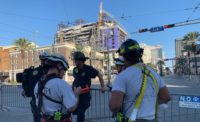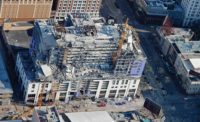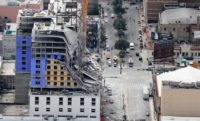The text of this article as updated on Nov. 24, 2019 to reflect new information.
When the under-construction Hard Rock Hotel in New Orleans partially collapsed on Oct. 12, the initial response was one of search and rescue, as well as a dramatic effort to secure the site that led to the controlled demolition of two tower cranes.
Now more than a month out from the disaster, the City of New Orleans has said that the entire building will be demolished. The mayor’s office announced on Nov. 12 that the building’s owner, 1031 Canal Development LLC, has contracted Kolb Grading LLC and its subsidiary, Dem/Tech, to perform a controlled implosion of the remaining structure. In a statement to the press, the mayor’s office said that after the implosion, a search-and-rescue team will recover the remains of the two construction workers who were still in the unstable structure. Demolition is expected to take place in January 2020 at the earliest.
The relatively slow effort to demolish the structure comes after a dramatic scramble to contain the site following the collapse. The two tower cranes at the site were safely brought down in a controlled demolition on Oct, 20. Despite this successful effort the remaining crane debris on the collapsed structue was only fully secured on Nov. 22, with crews using wire rope to lash the crane segments to the building.
In the aftermath of the crane implosions, ENR has learned that the unorthodox plan to bring down the two damaged tower cranes at the site came from an ongoing assessment from structural engineers, demolition experts and city and state officials that took quick decision-making and clever thinking.
“We were first contacted on Saturday [Oct. 12] and were on the site Sunday at 7 a.m.,” recalls David Griffin of demolition contractor D.H. Griffin, who was brought in by the City of New Orleans. “Initially we were there to figure out what had just happened, but it didn’t take long to see we had to deal with the cranes.” Griffin put in a call to John Abruzzo and Gary Panariello, structural engineers at Thornton Tomasetti with a history of investigating collapsed buildings. He also called up Mark Loizeaux of Controlled Demolition Inc., to consult. It was the first time they had seen each other as a group since working together at Ground Zero in New York City after the Sept. 11, 2001, attacks.
“So on Monday morning, Gary went and looked at the cranes and I looked at the structure,” says Abruzzo. “We were still trying to establish where the collapse zone was.” Panariello could see significant damage to the tower cranes, with all tie-ins clearly deformed and the towers way out of plumb. “There was significant deflection in one crane, cantilevering more than 250 ft in the air,” recalls Panariello. “Both cranes were bent and had significant amounts of debris pushing against the tower.” Panariello saw that the danger zone was much larger than first thought. “We had to do something. The cranes were in danger of falling while firefighters were still doing search and rescue.”
Engineer Renaldo Schweiger from crane manufacturer Liebherr flew in and provided the complete schematics of the cranes, which at 300 ft and 250 ft were overloaded and at risk of failure. “We began talking explosives, since it meant you wouldn’t have to have people beneath the cranes for long,” says Panariello. “We also came to the conclusion with Liebherr and [crane owner] Morrow Equipment that these cranes were a write-off.”
Other options, such as tying off the cranes to the building with wire rope, were explored, but Abruzzo says the instability of the building ruled that out. “And we didn’t want to put people on them. We needed to do this as cleanly as possible.”
While it was a team effort and the city and state officials had to sign off on it, Panariello admits the controlled demolition was his idea. “But it was a consensus opinion,” he adds.
Loizeaux got the sign-off on a controlled implosion to drop the cranes on Tuesday, and within a few days CDI crews were placing explosive charges at key points on the cranes. While Loizeaux concedes that demolishing two tower cranes in the middle of a city is unusual, CDI followed standard procedures for felling steel structures. The blast dropped the boom and counterweight of each crane before breaking each tower halfway up. This kept the debris within the footprint of the collapse, a huge relief for the entire disaster response team.
“We did a lot of modeling before: there were a lot of permutations of what could happen,” says Abruzzo. “But I didn’t think that one upper section would flip and lawn-dart into the ground,” to which Panariello quickly added: “I did.”







Post a comment to this article
Report Abusive Comment